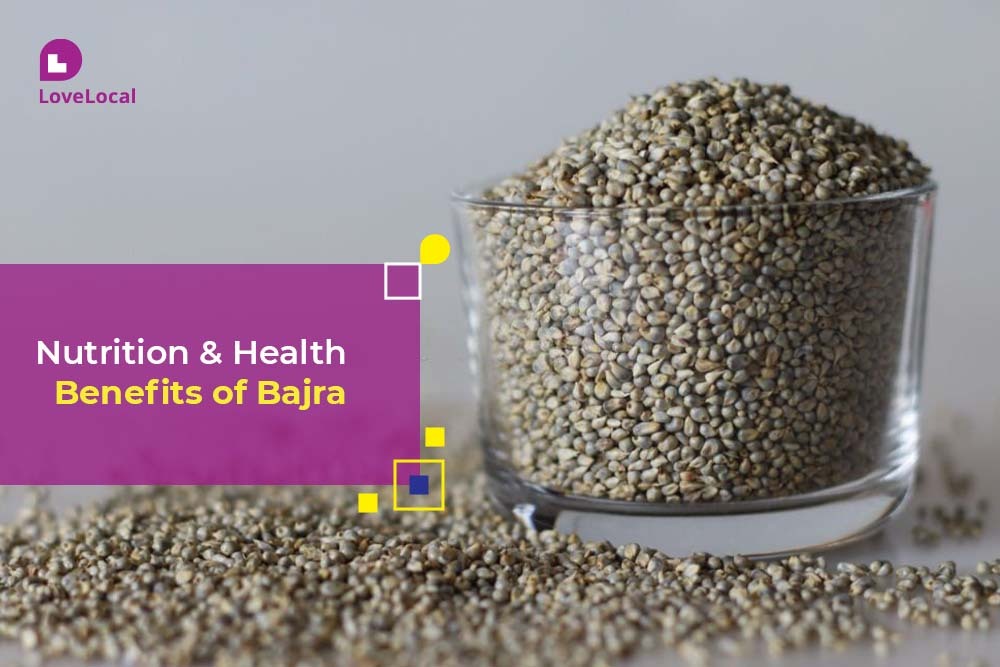Bajra, also known as pearl millet, is a staple in many Indian households. But its popularity has waned over the years. Now, it’s making a comeback, and for good reason. This nutritious grain is packed with vitamins and minerals and has many health benefits. In this blog, we’ll explore the benefits of bajra grain and some creative ways to incorporate it into your diet.
The Nutritional Value of Bajra:
Kambu millet is a nutrient-dense grain that’s rich in vitamins and minerals. It’s a good source of protein, fiber, and complex carbohydrates, and is low in fat. Here are some of the key nutritional components of bajara:
- Carbohydrates: Sajje is a complex carbohydrate that provides sustained energy to the body.
- Protein: Jowar bajra is a good source of plant-based protein, which is important for vegetarians and vegans.
- Fiber: Bajara is high in fiber, which helps regulate digestion and promotes a feeling of fullness.
- Vitamins: Bajara is rich in B-complex vitamins, including thiamine, riboflavin, niacin, and folate. These vitamins are essential for energy production, healthy skin, and proper brain function.
- Minerals: Bajra/Kambu is a good source of important minerals like iron, magnesium, phosphorus, and potassium. These minerals play a vital role in maintaining bone health, regulating blood pressure, and supporting the immune system.
Overall, it is a nutritious and wholesome grain that provides a range of health benefits when included in a balanced diet.
Health benefits of Bajra:
Bajra, also known as pearl millet, offers a range of health benefits due to its nutrient-dense composition. Here are some of the key health benefits of kambu:
- Improved Digestion: Kambu is high in fiber, which promotes healthy digestion and helps prevent constipation. It also contains prebiotics that support the growth of beneficial gut bacteria.
- Reduced Risk of Heart Disease: It is low in cholesterol and contains antioxidants that help reduce inflammation and lower the risk of heart disease. It’s also rich in potassium, which helps regulate blood pressure.
- Weight Loss: Sajje is a low glycemic index food, which means it helps regulate blood sugar levels and keeps you feeling full for longer. This can help with weight loss and weight management.
- Diabetes Management: Bajara has a low glycemic index, which means it doesn’t cause a rapid spike in blood sugar levels. This makes it a good choice for diabetics, as it can help regulate blood sugar levels and prevent complications.
- Improved Bone Health: Kambu is rich in magnesium, phosphorus, and calcium, which are essential minerals for strong bones. Regular consumption of bajra can help improve bone health and prevent conditions like osteoporosis.
Overall, bajra grain is a nutritious and wholesome grain that offers a range of health benefits. It’s a good addition to a balanced diet and can be consumed in various forms, including flatbreads, porridges, and salads.
Side effects of Bajra:
It is generally safe for consumption and does not have any significant side effects when consumed in moderation. However, some individuals may experience minor side effects due to an allergy or intolerance to it or its components. Here are some possible side effects:
- Allergic Reactions: Some individuals may be allergic to it or its components and may experience symptoms like skin rashes, itching, swelling, or difficulty breathing.
- Digestive Issues: Bajra atta is high in fiber, which can cause digestive issues like bloating, gas, or constipation if consumed in excess.
- Goiter: It contains goitrogens, which are substances that can interfere with thyroid hormone production and lead to goiter or an enlarged thyroid gland in some individuals.
- Interference with Iron Absorption: Sajje contains phytic acid, which can bind to minerals like iron and reduce their absorption in the body.
It’s important to consume bajara in moderation as part of a balanced diet to avoid any possible side effects. If you experience any adverse reactions after consuming it, it’s recommended that you consult a healthcare professional.
Creative Ways to Incorporate Bajra into Your Diet
Bajra is a versatile grain that can be incorporated into your diet in many ways. Here are some creative ways to enjoy it:
- Flatbreads: Bajra flour can be used to make nutritious flatbreads like bajra bhakri or paratha. These can be paired with vegetables, lentils, or curries for a complete meal.
- Porridge: Bajra atta can be used to make a warm and comforting porridge by cooking it with milk, water, and your choice of sweetener. Top it with nuts, fruits, or seeds for added flavor and nutrition.
- Salad: Kambu millet can be used to make a healthy and filling salad by combining it with fresh vegetables like cucumber, tomato, and bell pepper. Drizzle with a lemon and olive oil dressing for added flavor.
- Soup: Bajara can be added to soups for a hearty and nutritious meal. Combinw it with vegetables, lentils, or beans and cook in a flavorful broth for a warm and satisfying soup.
- Smoothies: Bajra flour can be added to smoothies for a nutritious and filling drink. Combine it with your favorite fruits, nuts, and seeds for added flavor and nutrition.
Overall, there are many creative ways to incorporate bajara into your diet. Whether you prefer it in flatbreads, porridges, salads, soups, or smoothies, it is a versatile grain that can provide a range of health benefits.
The price of Sajje:
The Bajra price in India can vary depending on various factors such as location, season, demand, and supply. It’s best to check with local markets or online grocery stores for current price information.
Conclusion:
Bajra is a nutritious and versatile grain that’s making a comeback. With its many health benefits and creative ways to use it, there’s no reason not to incorporate this superfood into your diet. Shop at LoveLocal to support local retailers!



